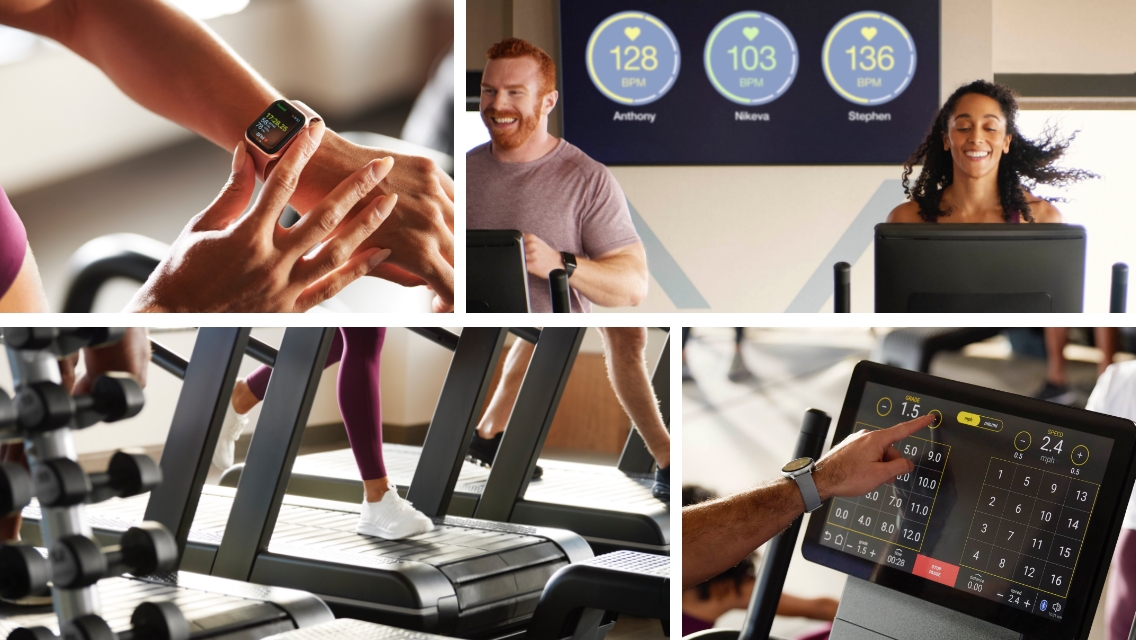With the right nutrition, exercise, and lifestyle choices, you can become a more efficient fat-burner with an optimized metabolism. The more energy you burn during the day and the better you are at burning fat, the easier it becomes to stay lean.
When you burn fat, you end up with fewer cravings for sugary foods as well. Alternatively, burning carbs when needed, such as during high-intensity training, is important for overall performance and fitness.
Each person burns fat and carbohydrates as fuel at varying rates, different intensities, or heart rates, and it’s important that your body is trained to burn the right fuel at the right time. This is called metabolic flexibility.
A well-designed conditioning program teaches your body the right way to burn fuel to optimize your health, body composition, and overall fitness. At Life Time, we have a simple means of measuring how much fat versus carbohydrate you burn at varying exercising intensities. From there, we can create a personalized cardio program to enhance your metabolic flexibility so you can feel and function your best.
The Active Metabolic Assessment™ (Our Gold Standard)
Using our medical-grade device, we can measure exactly how much oxygen you consume, and how much carbon dioxide you expire as you exercise at varying intensities.
Using that data, we’re able to determine how many calories, and how much carbohydrates and fat you burn.
With that information, we’re able to create a five-zone training profile, which we use to develop your cardio program.
I’ll explain the zones first. Then, offer a couple of alternatives if you can’t get your Active Metabolic Assessment done.
By the end of this article, you’ll know your zones created through our Gold, Silver, or Bronze methods. We even put together a couple of example workouts to get you moving. No matter which method you choose, monitoring your heart rate during workouts will yield the best results.
If you’re interested in the test, talk to a fitness professional at your local Life Time.
Heart-Rate Training Zones
To fully appreciate how we create your cardio program, you need to understand how your training zones work.
Zone 1: Zone 1 is a very easy intensity level. Moving in this zone feels like something you could do for hours, such as going for a long, leisurely walk. This zone is valuable for supporting recovery and is an important part of general health.
Aerobic Base: We call the point between Zone 1 and Zone 2 your aerobic base. We calculate it as the intensity at which you’re most efficient at burning fat.
One of the major goals of a heart-rate training program is to increase your aerobic base. As aerobic base increases, you have to work harder to maintain the same heart rate.
If you work harder while still burning a maximal level of fat, you burn more total calories and use up more stored fat.
Zone 2: In Zone 2, your breathing gets a little heavier. You’re still able to carry on a conversation with someone, pausing to catch your breath now and then. You’ll likely start sweating after a small amount of time in this zone.
Zone 3: In Zone 3, you’ll notice that you need to breathe through your mouth. You also begin to feel a little less comfortable in this zone.
Anaerobic Threshold (AT): The point at which your fat-burning drops dramatically and your body relies much more on carbohydrates is called your anaerobic threshold. It is rare that people exercise for extended periods of time above this point.
In fact, your body would be limited in how long it could last above this line — but that doesn’t mean there isn’t value in occasionally crossing it.
We often construct interval-training sessions for our clients where they spend certain periods of time above AT, and longer periods below it in Zones 2 and 3.
By spending part of your cardiovascular training time above threshold, you’ll notice that your recovery time between resistance training sets improves as well.
Zone 4: Zone 4 is used for shorter periods of time, like minutes, for the purpose of increasing VO2 max, a marker of cardiovascular capacity. It may also be used to increase running or cycling speed.
Zone 5: Zone 5 can only be sustained for very short periods of time, often less than a minute. Getting to this heart rate requires all-out sprints, Tabata–style cardio, or very high-repetition resistance training sets.
Silver and Bronze Methods
What happens when you can’t get your Active Metabolic Assessment done, or you don’t have access to a Life Time?
In such cases, use our Silver Method or Bronze Method to approximate your training zones. They’re not perfect, but they’re better than using the wildly inaccurate heart-rate chart found on most cardio equipment.
As you’d expect, the Silver Method is more accurate than the Bronze Method. And our Gold Method AMA is the most accurate of all.
While the Silver Method and Bronze Method are better than using whatever a treadmill or bike recommends for a heart-rate zone, they are still much less accurate than the Gold Standard AMA. Sometimes, we just have to work with the best option available.
Silver Method
Select a piece of cardiovascular equipment.
Then, put on a heart-rate monitor. Gradually increase your intensity over a 10-minute period to the point where you begin to feel uncomfortable and your breathing is heavy. Note your heart rate.
The point where your breathing becomes heavy and more uncomfortable is an estimate of your anaerobic threshold.
Bronze Method
The Bronze Method requires nothing more than a calculator to determine your anaerobic threshold. Subtract your age from 180, then:
- Subtract another 10 if you have not been exercising.
- Subtract 0 if you have been exercising two to three times per week for the past year.
- Add 10 if you have been exercising four times per week for the past few years.
This number is your estimated anaerobic threshold.
Determining Your Zones
Since we can’t measure how well your body burns fat with the Bronze and Silver methods, we have to use some equations to determine your zones. Plug in your estimated anaerobic threshold, and then calculate your zones based on the percentages shown:
| Zone | Range |
|---|---|
| Zone 1 | 60–70 percent AT |
| Zone 2 | 70–90 percent AT |
| Zone 3 | 90 percent AT |
| Zone 4 | 100–110 percent AT |
| Zone 5 | 110+ percent |
Using the Zones
One of the greatest mistakes we see people make is going “all out” for as long as they can handle it. They spend too much time in Zones 3–5 and see little improvement in body composition or performance.
We recommend most people design their training programs so 80 percent of their time is spent in Zones 1 and 2, and 20 percent of their time is spent in Zones 3–5.
The easiest way to keep track of this is by using a heart-rate monitor, which can store your workouts and track how much time you spend in the various zones.
Over the course of a week, at least 80 percent of your time should be in Zones 1 and 2.
For some people, all of their time should be spent in these zones. The better you adhere to our recommendations, the faster your zones will change.
Nutrition choices, genetics, medications, and lifestyle factors greatly affect how your zones change as well. You should have your zones rechecked every two to three months.
Read more about the proper way to do cardio here: “How Much Cardio Do You Really Need?”
Heart-Rate Zone Benefits and Feelings
| Zone | Good For | Feels Like |
|---|---|---|
| 1 | Promotes fat-burning and aids in recovery from days of more intense exercise. | Easy-peasy. You could do this for hours. |
| Base |
Your aerobic base is the heart rate at which your body most efficiently burns fat. It’s Ideal for endurance training and recovery workouts. You can do aerobic base training most days of the week without adding stress to your system. Read more about your aerobic base here: “Becoming an Effective Fat Burner: How to Build Your Aerobic Base” |
|
| 2 | Trains your body to burn fat efficiently and improve endurance. | Breathing is heavier, but you’re fairly comfortable. |
| 3 | Increases your tolerance for anaerobic training. Ideal for fat burning, cardio training, and exercise tolerance. It has notable benefits for those who are training for a race or event, and it also can be used in interval training for those who are new exercisers who are building their conditioning. This zone and higher adds some additional stress to the system that warrants recovery time (where heart rate and breathing decrease). | Your breathing is heavy and you’re working hard. |
| Threshold | The point at which your body shifts from burning mostly fat to mostly carbs. Ideal for fat burning, cardio training, and exercise tolerance. Doing some interval training above AT (with longer recovery periods down into Zones 1 and 2) is critical for improving your overall fitness and cardiovascular health. | |
| 4 |
Increases your peak VO2 and anaerobic threshold. Ideal for cardio and speed training. Your VO2 score is a reliable indicator of health and fitness levels. Read more here: “How to Increase Your VO2 Score” |
You feel winded and you’re pushing yourself very hard. |
| 5 | Increases your peak VO2 and anaerobic threshold. Good for sprinting, Tabata, or HIIT. | You can barely catch your breath. You’re at your body’s absolute max. |
Example Workouts
For an overview, follow the recommended frequency of workouts and intensities below.
You should consistently increase your speed, resistance, or incline in order to maintain your heart rate in the proper zones. (Note that most of the time is spent below anaerobic threshold.)
After implementing a well-designed conditioning program, your exercise metabolism and workloads in each zone typically shift within six to 12 weeks. At that point, you’ll want to reassess to determine your updated zones.
Low-Intensity Intervals
Perform 2–4 times per week. Repeat for a total of 30–60 minutes.
|
Zone |
Time |
Activity |
|
1 |
5 minutes |
Easy walk or jog |
|
2 |
5 minutes |
Slightly faster walk, jog, or run |
Moderate-Intensity Intervals
Perform 1–3 times per week. Repeat for a total of 20–30 minutes.
|
Zone |
Time |
Activity |
|
3 |
4 minutes |
Fast walk, walk uphill, or run |
|
1 |
1 minute |
Stand still or easy walk |
High-Intensity Intervals
Perform 1–2 times per week. Repeat for a total of 10–20 minutes.
|
Zone |
Time |
Activity |
|
4 |
1 minute |
Easy walk or jog |
|
1 |
1 minute |
Slightly faster walk, jog, or run |




